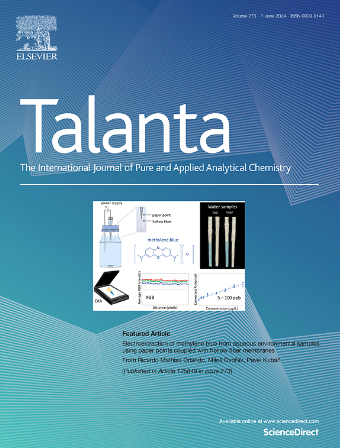IF 5.6
1区 化学
Q1 CHEMISTRY, ANALYTICAL
引用次数: 0
摘要
大麻的非刑罪化和合法化增加了大麻的消费量,也增加了对有效监测方法的需求。合成大麻素虽然在化学性质上有别于四氢大麻酚等天然大麻素,但其药效更强,会造成严重的不良影响,往往无法通过传统的药物检测方法检测出来。因此,亟需新型生物传感器来快速、灵敏、可靠地检测生物样本中的这些化合物。本研究介绍了一种新型电化学免疫传感器,它基于胺化 MXene 与聚丙烯碳酸酯(PPC)纳米纤维和单克隆抗体的整合,旨在提高合成大麻素的检测能力。电纺在丝网印刷电极(SPE)上的 PPC/MXene-NH₂ 纳米纤维增大了表面积,提高了灵敏度、稳定性和选择性。该生物传感器在唾液中的检测范围宽达 0.6-2000 纳克/毫升,检测限(LOD)低至 0.66 纳克/毫升,并表现出极佳的特异性。它具有很高的重复性和再现性,信号衰减极小,真空密封储存可显著延长传感器的长期稳定性。这些结果凸显了 MXene 增强型 PPC 纳米纤维免疫传感器作为灵敏、选择性强的便携式工具,在临床和法医环境中快速检测合成大麻素的潜力。本文章由计算机程序翻译,如有差异,请以英文原文为准。

MXene-poly(propylene carbonate) nanofiber network-based modification of SPE interfaces for electrochemical immuno-sensing of synthetic cannabinoid
The decriminalization and legalization of cannabis have increased its consumption and the need for effective monitoring methods. Synthetic cannabinoids, while chemically distinct from natural cannabinoids like THC, can be more potent and cause severe adverse effects, often evading detection by traditional drug tests. Thus, there is a critical need for new biosensors that offer rapid, sensitive, and reliable detection of these compounds in biological samples. This study presents a novel electrochemical immunosensor based on aminated MXene integrated with poly(propylene carbonate) (PPC) nanofibers and monoclonal antibodies designed to enhance the detection of synthetic cannabinoids. The PPC/MXene-NH₂ nanofibers, electrospun onto screen-printed electrodes (SPEs), provide increased surface area and high sensitivity, stability, and selectivity. The biosensor achieved a wide detection range of 0.6–2000 ng/mL in saliva, a low limit of detection (LOD) of 0.66 ng/mL, and demonstrated excellent specificity. It showed high repeatability and reproducibility with minimal signal degradation, with vacuum-sealed storage proving to significantly extend sensor stability over time. These results highlight the potential of MXene-enhanced PPC nanofiber immunosensors as sensitive, selective, and portable tools for rapid detection of synthetic cannabinoids in clinical and forensic settings.
求助全文
通过发布文献求助,成功后即可免费获取论文全文。
去求助
来源期刊

Talanta
化学-分析化学
CiteScore
12.30
自引率
4.90%
发文量
861
审稿时长
29 days
期刊介绍:
Talanta provides a forum for the publication of original research papers, short communications, and critical reviews in all branches of pure and applied analytical chemistry. Papers are evaluated based on established guidelines, including the fundamental nature of the study, scientific novelty, substantial improvement or advantage over existing technology or methods, and demonstrated analytical applicability. Original research papers on fundamental studies, and on novel sensor and instrumentation developments, are encouraged. Novel or improved applications in areas such as clinical and biological chemistry, environmental analysis, geochemistry, materials science and engineering, and analytical platforms for omics development are welcome.
Analytical performance of methods should be determined, including interference and matrix effects, and methods should be validated by comparison with a standard method, or analysis of a certified reference material. Simple spiking recoveries may not be sufficient. The developed method should especially comprise information on selectivity, sensitivity, detection limits, accuracy, and reliability. However, applying official validation or robustness studies to a routine method or technique does not necessarily constitute novelty. Proper statistical treatment of the data should be provided. Relevant literature should be cited, including related publications by the authors, and authors should discuss how their proposed methodology compares with previously reported methods.
 求助内容:
求助内容: 应助结果提醒方式:
应助结果提醒方式:


